
Heavy Metal Detox
Removal of harmful heavy metal buil-up in the body
Why Heavy Metal Detox?
Heavy metals like lead, mercury, cadmium, and arsenic can build up in tissues over time, potentially overwhelming the body’s natural detoxification processes. An herbal detox aims to support the liver, kidneys, and digestive system in eliminating these metals, helping to reduce the overall toxic load on the body.
Sarah's Herbal Garden
Heavy Metal Detox Bundle
Share
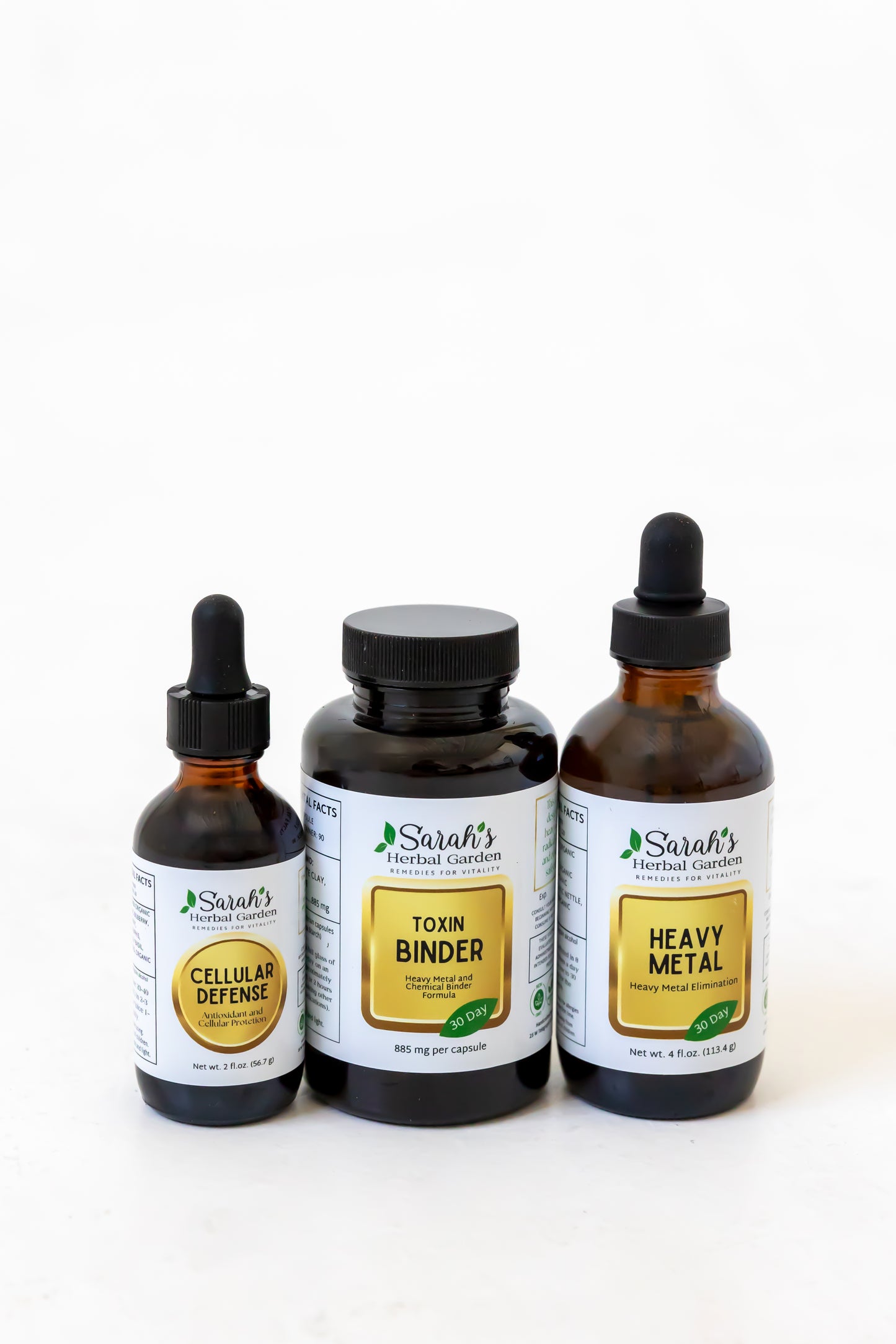







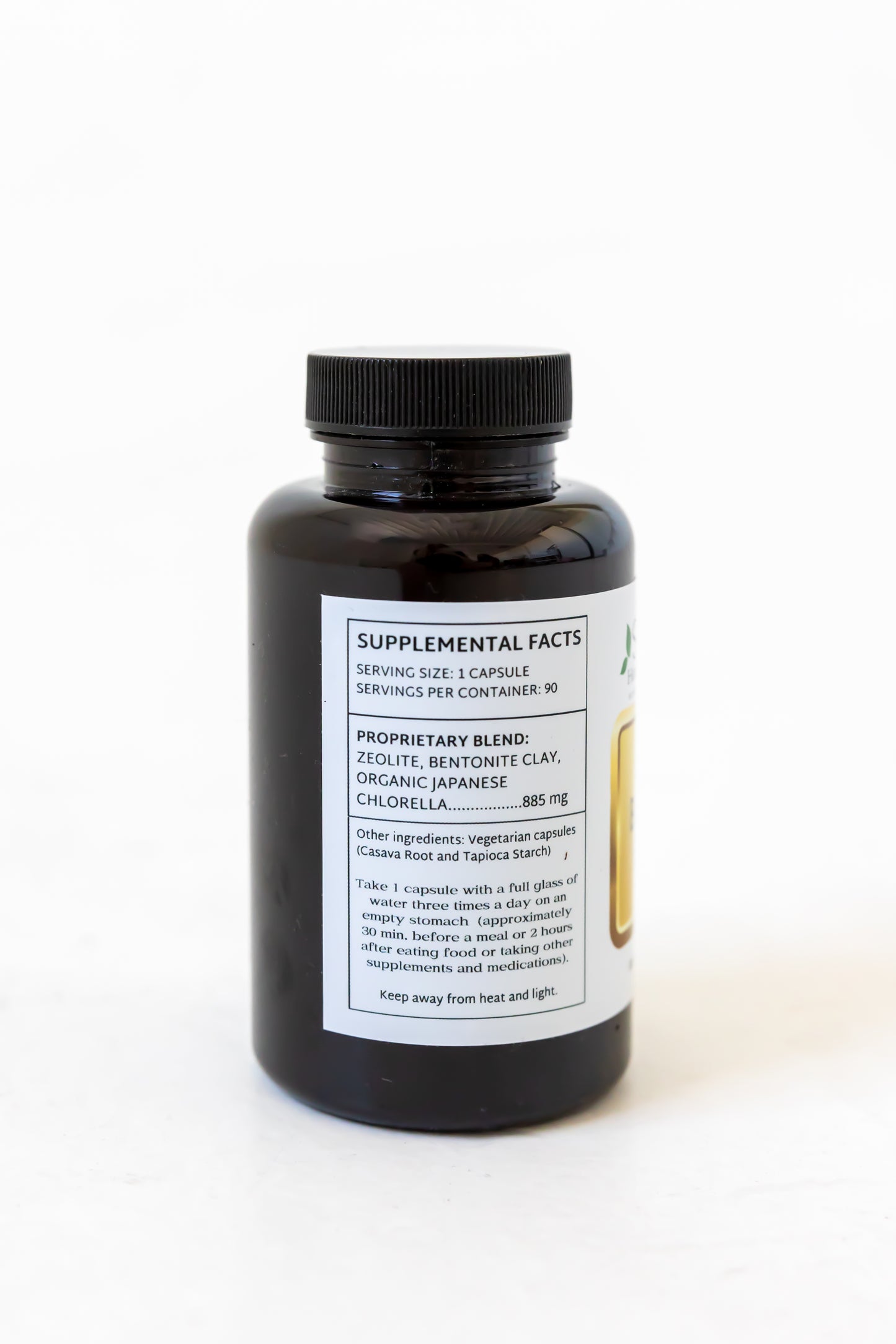
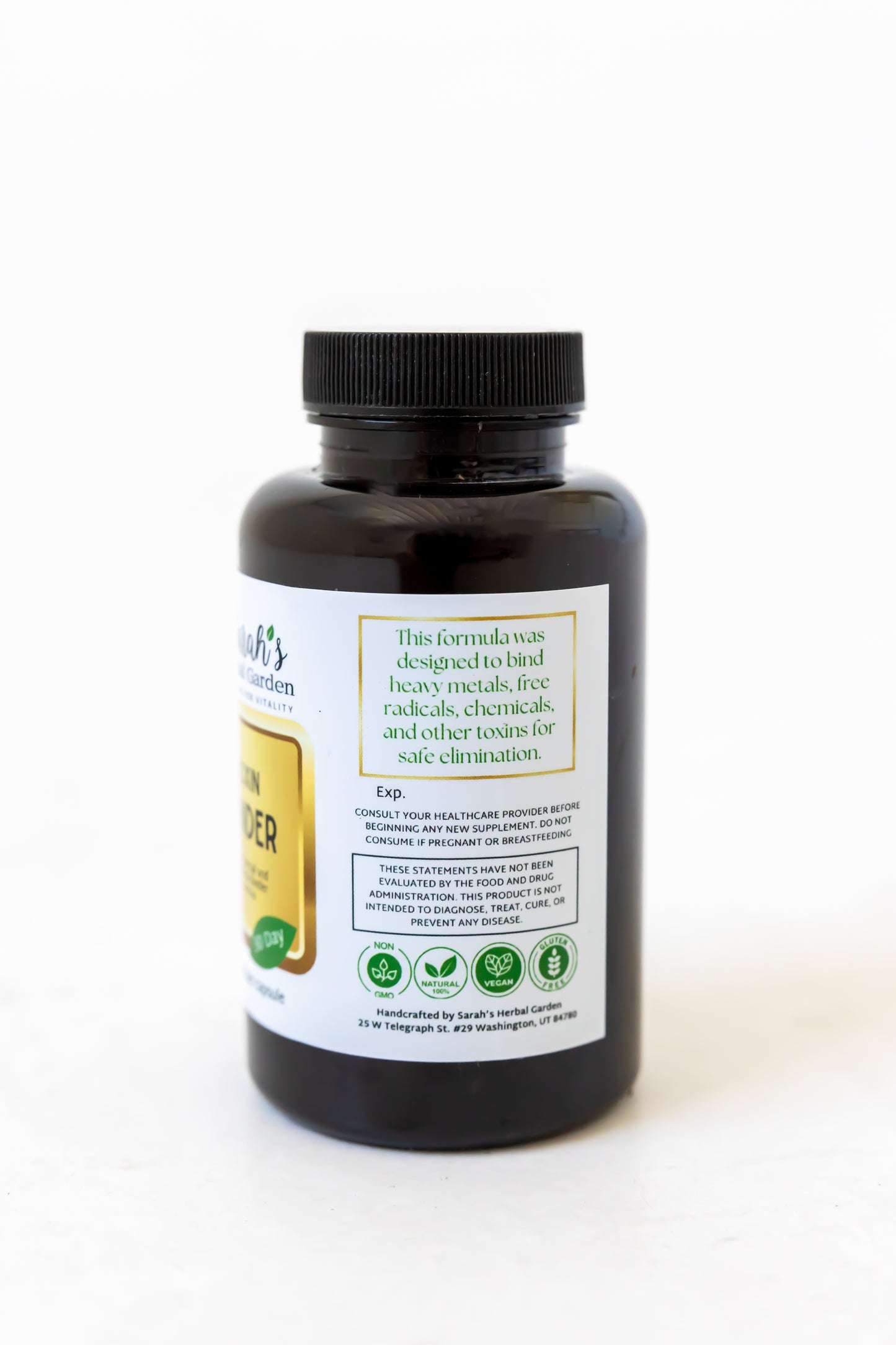
There are a number of benefits that may result from a heavy metal detox:
-

Improve Neurological Function
Accumulation of metals such as mercury and lead has been linked to cognitive decline, memory loss, and neurological disorders like Alzheimer’s and Parkinson’s. Detoxing may help reduce these risks by eliminating metals that affect the brain and nervous system. Some people report that detoxing from heavy metals helps reduce brain fog, anxiety, and mood swings. This may be due to the removal of toxins that affect cognitive and emotional functioning.
-

Improved Immune Function
Heavy metals can impair immune system function, making the body more susceptible to infections, chronic inflammation, and autoimmune disorders. Herbal detoxification may help restore immune balance and reduce inflammation.
-

Enhanced Energy Levels
Chronic exposure to heavy metals can lead to fatigue, muscle weakness, and general malaise. An herbal detox can assist the body in eliminating toxins that interfere with energy production, potentially improving overall vitality and physical well-being.
-

Prevent or Address Chronic Illness
Long-term exposure to heavy metals has been associated with chronic diseases such as cardiovascular disease, kidney damage, and cancer. Detoxing can be part of a preventative or supportive therapy to mitigate the potential health risks associated with these metals.
-

Improve Skin Health
Heavy metals can manifest in the skin, causing rashes, irritation, or pigmentation issues. By detoxing, individuals may experience improvements in skin clarity and texture, as toxins are flushed out.
-

Restore Nutrient Absorption
Heavy metals may interfere with the body’s ability to absorb essential nutrients like calcium, magnesium, and iron. Detoxing can improve digestive health and nutrient uptake, leading to better overall nutrition.
These are some common sources of heavy metals in our environments
Minimize your exposure to heavy metals
Contaminated Water
- Lead and mercury can contaminate drinking water due to old plumbing systems (lead pipes) or industrial pollution.
- Arsenic may be present in groundwater, particularly in areas where natural deposits or agricultural runoff (such as pesticides) contaminate the water supply.
(It is recommended that you invest in a quality water filtering system or source purified spring water or distilled water)
Food Sources
- Mercury is often found in seafood, especially in large predatory fish like tuna, swordfish, and shark, due to bioaccumulation in the marine food chain.
- Cadmium can be present in leafy vegetables and grains grown in contaminated soil.
- Arsenic may be found in rice and rice-based products due to its absorption from soil and water, especially in areas where arsenic-based pesticides have been used.
- Lead can contaminate food grown in areas with polluted soil or from industrial waste runoff.
Air Pollution
- Lead, mercury, cadmium, and other heavy metals are present in the air due to industrial emissions, burning of fossil fuels, waste incineration, and vehicle exhaust.
- Exposure to metal dust or fumes in industrial settings, mining, or smelting can result in inhalation of toxic heavy metals.
Household Products
- Lead-based paint: Houses built before the 1970s may still contain lead-based paint, which poses a risk if the paint chips, peels, or turns into dust.
- Household items: Some ceramics, imported pottery, and even certain cosmetics or folk remedies may contain heavy metals like lead, mercury, or cadmium.
- Batteries: Improper disposal of batteries, which contain cadmium or lead, can lead to environmental contamination.
Occupational Exposure
- Workers in industries such as mining, battery manufacturing, metal plating, welding, or electronics recyclingmay be exposed to heavy metals like lead, cadmium, chromium, and mercury through inhalation or skin contact.
- Construction workers involved in renovating or demolishing old buildings may encounter lead or asbestos.
Soil Contamination
- Heavy metals like lead, cadmium, and arsenic can accumulate in the soil due to industrial pollution, improper waste disposal, or use of contaminated fertilizers or pesticides.
- People may be exposed through gardening, farming, or playing in contaminated soil, or by consuming food grown in such soil.
Reducing Risks of Heavy Metal Exposure from Dental Work
- Opt for mercury-free fillings: Choose composite (resin-based) or ceramic fillings instead of amalgam fillings.
- Ask about metal-free crowns: Modern crowns made of zirconia or porcelain can be alternatives to metal-based crowns, reducing the risk of metal exposure.
- Ensure safe amalgam removal: If you have amalgam fillings that need to be removed, seek a dentist who specializes in safe mercury removal protocols.
- Consider biocompatible materials: Some dentists specialize in using biocompatible and non-toxic materials that minimize heavy metal exposure in dental work.
Here are some foods that can help eliminate heavy metals in the body:
-

Cilantro
Cilantro is one of the most effective natural chelators, meaning it binds to heavy metals like lead, mercury, and aluminum, helping to remove them from the body.
-

Spirulina
Spirulina is a blue-green algae rich in nutrients that helps bind heavy metals, especially mercury, and promotes their elimination.
-

Coconut Oil
Coconut oil can support the immune system and has antimicrobial properties that may protect against the effects of heavy metal toxicity. It also promotes liver function and helps in the metabolism of toxins.
-

Seaweed (Wakame, Nori, Kombu)
Seaweed is rich in alginate, a compound that binds to heavy metals in the body and helps eliminate them through the digestive tract. Seaweed also supports thyroid health, which can be impacted by heavy metal exposure.
-

Leafy Greens (Kale, Spinach, Swiss Chard)
Leafy greens are packed with chlorophyll, which binds to heavy metals and helps eliminate them from the body. They are also rich in fiber, which supports the digestive system’s ability to remove toxins.
-

Citrus fruits
Citrus fruits are high in vitamin C, which is essential for neutralizing free radicals and supporting the liver's detox processes. Vitamin C also helps prevent heavy metals from being absorbed into the body.
-

Garlic
Garlic contains sulfur compounds that support the liver's detoxification processes, particularly in removing heavy metals like lead and mercury. Garlic also has antioxidant properties that protect against oxidative stress caused by heavy metals.
-

Cruciferous Vegetables (Broccoli, Cauliflower, Brussels Sprouts)
Cruciferous vegetables contain sulfur compounds that support the liver's detoxification enzymes. These enzymes are key in breaking down and eliminating toxins, including heavy metals.
-

Beets
Beets are rich in betaine and nitrates, which support liver detoxification and help eliminate toxins from the body. Beets also improve circulation and support the production of bile, which aids in detoxification.
-

Ginger
Ginger has anti-inflammatory and antioxidant properties that support detoxification, reduce oxidative stress, and promote healthy digestion. It also helps increase circulation, which aids in detox.
-

Turmeric
Turmeric contains curcumin, a potent antioxidant and anti-inflammatory compound that supports the liver's ability to detoxify heavy metals. It also reduces oxidative stress caused by toxic metal accumulation.
-

Apples
Apples are rich in pectin, a type of fiber that binds to heavy metals in the intestines and helps remove them from the body. Apples also contain antioxidants that aid detoxification.
-

Berries
Berries are rich in antioxidants, particularly anthocyanins, which help protect cells from oxidative damage caused by heavy metals. They also support liver detoxification.
-

Avocados
Avocados are rich in glutathione, one of the body’s most important antioxidants for detoxification. Glutathione helps the liver process heavy metals and other toxins for removal.
-

Flax Seed
These seeds are rich in fiber and omega-3 fatty acids, both of which support detoxification. Fiber binds to heavy metals in the digestive tract, helping to expel them from the body.
-

Dandelion Greens
Dandelion greens support liver and kidney function, both of which are essential for detoxification. They are rich in antioxidants and help promote bile production, which aids in eliminating heavy metals.
-

Onions
Onions are rich in sulfur-containing compounds, like garlic, which support liver detoxification and help break down and eliminate heavy metals.
-

Chia Seeds
When chia seeds are soaked in water, they form a gel-like substance. This gel can help cleanse the digestive tract by “scraping” away toxins, including heavy metals, and facilitating their elimination. They are also high in fiber and antioxidants.
-

Brazil Nuts
- Brazil nuts are a rich source of selenium, a powerful antioxidant that helps remove mercury from the body and supports overall detoxification by boosting liver function.
Are you toxic?
Signs and Symptoms of Heavy Metal Toxicity
Neurological Symptoms
Memory Loss: Difficulty concentrating or remembering things can occur, especially with mercury and lead toxicity.
Cognitive Decline: Heavy metals, particularly mercury and lead, can impair cognitive function and cause "brain fog."
Tingling or Numbness: Nerve damage from metals like arsenic and mercury can lead to tingling or numbness in the extremities.
Tremors or Shaking: Tremors or involuntary muscle movements can be caused by mercury and other neurotoxic metals.
Headaches: Persistent headaches may be a sign of heavy metal exposure affecting the nervous system.
Mood Changes: Anxiety, depression, irritability, or mood swings can result from prolonged heavy metal exposure.
Insomnia: Difficulty sleeping or disturbed sleep patterns are often reported.
Gastrointestinal Symptoms
Abdominal Pain: Chronic exposure to metals like arsenic or cadmium can lead to gastrointestinal discomfort or pain.
Nausea and Vomiting: Nausea, vomiting, and diarrhea may occur, particularly in cases of acute heavy metal poisoning.
Diarrhea or Constipation: Digestive problems, including diarrhea and constipation, can result from exposure to heavy metals.
Fatigue and Weakness
Chronic Fatigue: Fatigue that doesn’t improve with rest can be caused by the accumulation of heavy metals, which disrupt cellular energy production.
Muscle Weakness: Generalized weakness and lethargy are often symptoms of heavy metal toxicity, particularly with lead and mercury.
Immune System Impairment
Frequent Infections: Heavy metals can suppress immune function, making individuals more susceptible to infections.
Autoimmune Reactions: In some cases, heavy metal exposure can trigger autoimmune responses, where the immune system attacks the body’s own tissues.
Skin Issues
Rashes and Irritation: Skin rashes, itching, or lesions may occur with exposure to metals like arsenic.
Pigmentation Changes: Arsenic toxicity can cause changes in skin pigmentation or dark spots.
Hair Loss: Thallium and mercury toxicity, in particular, are associated with hair loss.
Kidney and Liver Damage
Kidney Dysfunction: Heavy metals like lead, cadmium, and mercury can cause kidney damage, leading to symptoms such as swelling, high blood pressure, or reduced urine output.
Liver Damage: Heavy metals can accumulate in the liver, leading to liver dysfunction, jaundice, and other liver-related symptoms.
Cardiovascular Issues
High Blood Pressure: Lead and cadmium exposure have been linked to hypertension (high blood pressure).
Arrhythmias: Irregular heartbeats or palpitations can occur as a result of heavy metal toxicity affecting the heart.
Anemia: Metals like lead can interfere with red blood cell production, leading to anemia and symptoms like fatigue, weakness, and pale skin.
Respiratory Symptoms
Coughing and Shortness of Breath: Inhalation of heavy metals such as cadmium or arsenic can lead to respiratory problems, including persistent coughing or difficulty breathing.
Lung Damage: Long-term exposure can cause chronic respiratory diseases and, in some cases, increase the risk of lung cancer.
Reproductive Issues
Infertility: Heavy metal toxicity can affect both male and female fertility, potentially leading to issues with conception.
Birth Defects: Exposure to heavy metals during pregnancy increases the risk of birth defects and developmental delays in children.
Menstrual Irregularities: Women exposed to heavy metals may experience irregular periods or other reproductive health issues.
Joint Pain
Joint Pain: Some heavy metals, like lead, can accumulate in the bones, causing joint pain and discomfort.
Bone Weakness: Prolonged exposure to metals like cadmium may lead to bone fragility and increase the risk of fractures.
Metallic Taste in Mouth
A persistent metallic taste, especially after consuming food or beverages, can be a symptom of heavy metal exposure, particularly with mercury or lead.
Endocrine Disruption
Thyroid Dysfunction: Heavy metals like mercury can interfere with thyroid hormone production, leading to symptoms like fatigue, weight gain, or cold intolerance.
Hormonal Imbalances: Some heavy metals disrupt endocrine function, potentially affecting metabolism, mood, and reproductive health.
Powerful detox practices
Prayer and Meditation
Prayer and meditation can contribute to detoxifying the body primarily through their effects on mental, emotional, and physiological well-being. Here are several ways these practices may aid in detoxification:
1. Stress Reduction
- Cortisol Levels: Both prayer and meditation on the word can lower cortisol levels, the stress hormone. High levels of cortisol can lead to various health issues, including the accumulation of toxins in the body.
- Relaxation Response: Inducing a state of deep relaxation helps in reducing stress, which supports the body's natural detoxification processes.
2. Improved Mental Clarity and Emotional Balance
- Emotional Release: Meditation and prayer can help release negative emotions and thoughts, which can be toxic to the mind and body.
- Mental Clarity: Achieving a state of mental clarity and emotional balance can lead to better lifestyle choices, including healthier eating and drinking habits.
3. Enhanced Immune Function
- Immune System Support: Reduced stress and improved emotional health can enhance immune function, making the body more effective at eliminating toxins.
- Inflammation Reduction: Meditation has been shown to reduce inflammation, which can help the body in clearing out toxins and waste products.
4. Improved Sleep Quality
- Sleep Regulation: Regular meditation and prayer can improve sleep quality, which is crucial for the body's detoxification processes. During sleep, the body repairs and detoxifies itself.
- Circadian Rhythms: These practices can help regulate circadian rhythms, promoting better overall health and detoxification.
5. Enhanced Mind-Body Connection
- Body Awareness: Meditation and prayer increase body awareness, helping individuals recognize and address physical and emotional stressors that may contribute to toxin buildup.
- Healthier Habits: A heightened mind-body connection can lead to healthier lifestyle choices that support detoxification, such as proper nutrition, hydration, and exercise.
6. Reduced Inflammation
- Anti-inflammatory Effects: Meditation has been linked to reduced markers of inflammation in the body, which can help in reducing the accumulation of toxins.
- Stress and Inflammation: By managing stress through prayer and meditation, the inflammatory response in the body is minimized, aiding in detoxification.
7. Increased Oxygenation
- Breathing Techniques: Many forms of meditation involve deep breathing techniques, which can increase oxygen supply to the body's cells, aiding in the removal of toxins.
- Cellular Detoxification: Improved oxygenation supports cellular health and the body's detoxification processes.
8. Hormonal Balance
- Hormone Regulation: Regular practice of meditation and prayer can help balance hormones, which is essential for the body's detoxification and overall health.
- Endorphin Release: These practices can stimulate the release of endorphins and other beneficial hormones that promote a sense of well-being and support detoxification.
9. Mindful Eating and Drinking
- Awareness: Meditation and prayer can promote mindfulness, leading to more conscious eating and drinking habits that reduce toxin intake and support detoxification.
- Healthy Choices: Increased mindfulness can lead to better dietary choices, avoiding processed foods and toxins, and opting for nutrient-rich, detoxifying foods.
10. Community and Support
- Social Connection: Engaging in prayer and meditation within a community can provide emotional support and a sense of belonging, reducing stress and promoting overall well-being. This is why the scriptures tell us to be unified in as a body (1 Corinthians 12:12-26)
- Shared Practices: Being part of a supportive community can reinforce healthy habits and lifestyle choices that contribute to detoxification.
Fasting
We believe fasting is a highly spiritual matter, and we recommend being prayerful about your approach. Isaiah 58:8 shows us that fasting even causes our health to "spring forth speedily." Many people do have spiritual experiences during a fast when the spirit is leading the process.
From a physical perspective, there are several ways fasting can assist in detoxification:
1. Rest for the Digestive System
- Digestive Efficiency: Fasting gives the digestive system a break, allowing it to repair and improve its efficiency.
- Reduction in Inflammation: It can reduce inflammation in the gut, potentially alleviating symptoms of conditions like irritable bowel syndrome (IBS).
2. Enhanced Cellular Repair and Autophagy
- Autophagy: During fasting, the body initiates a process called autophagy, where cells break down and remove damaged components. This helps in clearing out old cells and making room for new, healthy ones.
- Cellular Renewal: This process supports cellular renewal and can help eliminate dysfunctional cells, which might contribute to disease development.
3. Improved Insulin Sensitivity and Blood Sugar Regulation
- Insulin Sensitivity: Fasting can improve insulin sensitivity, reducing the risk of type 2 diabetes and helping to regulate blood sugar levels.
- Reduced Blood Sugar Levels: Lower and more stable blood sugar levels can reduce the production of advanced glycation end-products (AGEs), which are harmful compounds that can contribute to aging and chronic disease.
4. Hormonal Balance
- Hormone Regulation: Fasting affects various hormones, including increasing the production of norepinephrine, which can boost metabolism and enhance fat burning.
- Human Growth Hormone (HGH): Increased levels of HGH during fasting can aid in muscle repair and fat loss.
5. Fat Metabolism and Ketosis
- Ketosis: Fasting can lead to ketosis, where the body uses fat as its primary energy source instead of glucose. This process can help in burning stored fat, which can be a reservoir for toxins.
- Toxin Release: As fat stores are mobilized and used for energy, toxins stored in fat cells are released and can be processed and eliminated by the body.
6. Reduced Oxidative Stress
- Antioxidant Production: Fasting can increase the body's production of antioxidants, which help neutralize free radicals and reduce oxidative stress.
- Reduced Inflammation: Lower oxidative stress can lead to reduced inflammation, which is beneficial for overall health and disease prevention.
7. Improved Immune Function
- Immune System Reset: Short-term fasting can help regenerate the immune system by promoting the removal of damaged immune cells and stimulating the production of new ones.
- Disease Resistance: A healthier immune system is better equipped to fight off infections and diseases.
8. Enhanced Liver Function
- Liver Detoxification: The liver plays a central role in detoxification. Fasting can enhance liver function by giving it a break from constant digestion and allowing it to focus on detoxification processes.
- Glutathione Production: Fasting can increase the production of glutathione, a powerful antioxidant produced by the liver that helps detoxify harmful substances.
9. Mental and Emotional Clarity
- Mental Clarity: Many people report improved mental clarity and focus during fasting periods, which can contribute to overall well-being and reduce stress.
- Emotional Reset: Fasting can provide an opportunity for emotional and psychological reset, helping to break unhealthy eating patterns and develop a healthier relationship with food.
It's important to note that while fasting can offer these potential benefits, it is not suitable for everyone. People with certain medical conditions, pregnant or breastfeeding women, and those with a history of eating disorders should consult a healthcare professional before starting any fasting regimen. Additionally, the benefits of fasting can vary depending on the type, duration, and individual health status. Again, be prayerful about the type and duration of your fast so you can maximize it's healing potential.
Exercise
Exercise can play a significant role in detoxifying the body. Here are several ways in which physical activity helps support the body's natural detoxification processes:
- Increases Circulation: Exercise enhances blood flow, which helps transport oxygen and nutrients to cells while removing waste products. Improved circulation supports the efficiency of organs involved in detoxification, such as the liver and kidneys.
- Promotes Sweating: When you exercise, your body temperature rises, leading to sweating. Sweat helps remove toxins from the body through the skin, including heavy metals and other harmful substances.
- Boosts Lymphatic System: The lymphatic system relies on physical movement to circulate lymph fluid, which carries waste products and toxins away from tissues and toward the lymph nodes for filtration. Exercise helps stimulate lymphatic drainage, aiding in detoxification.
- Improves Digestion: Physical activity can enhance digestive health by promoting regular bowel movements, which help eliminate waste and toxins from the body more efficiently. Exercise also stimulates peristalsis, the muscle contractions that move food through the digestive tract.
- Supports Kidney Function: Exercise increases the rate at which blood is filtered through the kidneys, helping to remove waste products and toxins from the blood more effectively.
- Enhances Lung Function: Cardiovascular exercise increases respiratory rate, promoting deeper breathing. This helps expel carbon dioxide and other volatile toxins from the lungs.
- Reduces Fat Stores: Toxins can accumulate in body fat. By reducing body fat through regular exercise, you can help decrease the amount of stored toxins.
- Stress Reduction: Exercise helps reduce stress levels by releasing endorphins, the body's natural "feel-good" chemicals. Lower stress levels support overall health and the body's ability to detoxify efficiently.
Types of Exercise Beneficial for Detoxification:
- Cardiovascular Exercise: Activities like running, cycling, swimming, and brisk walking increase heart rate and circulation, promoting sweating and lung function.
- Strength Training: Lifting weights or doing bodyweight exercises helps build muscle, which can improve metabolism and support overall detoxification processes.
- Yoga: Yoga can enhance circulation, stimulate the lymphatic system, and improve digestion through specific poses and breathing exercises.
- High-Intensity Interval Training (HIIT): Short bursts of intense activity followed by periods of rest can effectively boost metabolism and promote detoxification.
- Rebounding: Jumping on a mini-trampoline (rebounder) can stimulate the lymphatic system and improve circulation.
Tips for Maximizing Detox Benefits of Exercise:
- Stay Hydrated: Drink plenty of water before, during, and after exercise to support kidney function and help flush out toxins.
- Maintain a Balanced Diet: Eat a nutritious diet rich in fruits, vegetables, and whole grains to provide the necessary nutrients for detoxification.
- Get Enough Sleep: Adequate rest is essential for the body to repair and regenerate, supporting detoxification processes.
- Practice Deep Breathing: Incorporate deep breathing exercises to enhance lung function and reduce stress.
- Consistency: Regular physical activity is key to maintaining the benefits of exercise for detoxification.
Precautions:
- Listen to Your Body: Avoid over-exercising, which can lead to injury and increased stress, counteracting the benefits.
- Consult a Professional: If you have any underlying health conditions, consult a healthcare provider or fitness professional before starting a new exercise regimen.
Staying Hydrated
Adequate hydration plays a crucial role in the body's detoxification processes. Here are several ways in which staying properly hydrated helps detoxify the body:
- Kidney Function: The kidneys are essential for filtering waste products and toxins from the blood and excreting them in urine. Adequate hydration ensures that the kidneys can effectively perform this function, reducing the risk of kidney stones and urinary tract infections.
- Liver Function: The liver processes toxins and waste products, converting them into substances that can be excreted by the body. Water is essential for these metabolic processes and helps transport waste products to the kidneys and intestines for elimination.
- Digestion: Water aids in digestion by helping break down food, absorb nutrients, and move waste through the digestive tract. Proper hydration prevents constipation and promotes regular bowel movements, which are vital for the elimination of toxins.
- Sweating: The body uses sweat to regulate temperature and excrete certain toxins through the skin. Adequate hydration ensures that the body can sweat effectively during physical activity or exposure to heat.
- Lymphatic System: The lymphatic system relies on water to transport lymph fluid, which carries waste products and toxins away from tissues and towards the lymph nodes for filtration. Proper hydration supports the efficient functioning of the lymphatic system.
- Cellular Function: Water is crucial for maintaining cellular health. It helps transport nutrients into cells and waste products out of cells, ensuring that cells function optimally and stay free from toxin buildup.
- Skin Health: Hydrated skin is more effective at excreting toxins through sweat and maintaining a barrier against external pollutants. Proper hydration helps keep the skin healthy and capable of performing its detoxification functions.
Tips for Maintaining Adequate Hydration:
- Drink Plenty of Water: Aim to drink at least 8 cups (2 liters) of water per day, or more if you are physically active, live in a hot climate, or are pregnant or breastfeeding.
- Consider Using Celtic Salt: Taking a small amount of celtic salt with water can increase hydration at the cellular level. Celtic salt contains minerals and electrolytes that are crucial for cellular hydration.
- Consume Hydrating Foods: Include fruits and vegetables with high water content in your diet, such as cucumbers, watermelon, oranges, and lettuce.
- Limit Dehydrating Beverages: Reduce intake of caffeine and alcohol, which can dehydrate the body. If you consume these beverages, compensate by drinking additional water.
- Monitor Urine Color: Aim for light yellow or clear urine, which indicates proper hydration. Dark yellow urine may be a sign of dehydration.
- Carry a Water Bottle: Keep a reusable water bottle with you throughout the day to encourage regular water intake.
- Set Reminders: Use reminders or apps to prompt you to drink water regularly, especially if you have a busy schedule.
Signs of Dehydration:
- Thirst
- Dry mouth and lips
- Dark yellow urine
- Fatigue
- Dizziness or lightheadedness
- Headaches
- Dry skin
Benefits of Staying Hydrated:
- Improved energy levels
- Enhanced cognitive function
- Better digestion and regularity
- Healthier skin
- Optimal kidney and liver function
- Effective toxin elimination
Detox Baths
The skin is the largest organ in the body, and vital to eliminating toxic waste from the body! Check out our favorite herbal salt tub tea!
Epsom Salt (Magnesium Sulfate):
- Benefits: Epsom salt is believed to help draw out toxins through the skin, reduce inflammation, relieve muscle aches and pains, and promote relaxation.
- Usage: Add 1-2 cups of Epsom salt to a warm bath and soak for 20-30 minutes.
Baking Soda (Sodium Bicarbonate):
- Benefits: Baking soda is thought to neutralize acids on the skin, soothe irritation, and detoxify by drawing out impurities.
- Usage: Add 1/2 to 1 cup of baking soda to your bathwater.
Apple Cider Vinegar:
- Benefits: Apple cider vinegar is believed to help balance the skin's pH, soothe skin irritations, and promote detoxification.
- Usage: Add 1-2 cups of apple cider vinegar to a warm bath and soak for 20-30 minutes.
Sea Salt:
- Benefits: Sea salt can help exfoliate the skin, improve circulation, and provide minerals that are absorbed through the skin.
- Usage: Add 1-2 cups of sea salt to your bath.
Bentonite clay:
- Benefits: Bentonite clay baths can offer a range of benefits, including detoxification, improved skin health, reduced inflammation, and pain relief.
- Usage: Use food-grade bentonite clay for the bath to ensure it is safe and free from contaminants. Add 1-2 cups of bentonite clay to warm water. Stir the water with your hand or a wooden spoon to ensure the clay is evenly distributed and fully dissolved. After the bath, rinse off with clean water to remove any residual clay from your skin.
Essential Oils (e.g., Lavender, Eucalyptus, Tea Tree):
- Benefits: Essential oils can provide aromatherapy benefits, such as relaxation (lavender), respiratory relief (eucalyptus), and antimicrobial effects (tea tree).
- Usage: Add a few drops of essential oils to your bath or mix them with a carrier oil before adding to the bathwater.
Ginger:
- Benefits: Ginger can promote sweating, which may help eliminate toxins through the skin and provide a warming, soothing effect.
- Usage: Add 1-2 tablespoons of grated fresh ginger or powdered ginger to your bath.
Potential Benefits of Detox Baths:
- Relaxation: Detox baths can provide a calming and relaxing experience, reducing stress and promoting a sense of well-being.
- Muscle Relief: Ingredients like Epsom salt can help relieve muscle tension and soreness.
- Skin Health: Many detox bath ingredients can soothe and improve skin health, reducing irritation and providing hydration.
- Improved Circulation: Warm baths can improve blood circulation, aiding in the delivery of oxygen and nutrients to tissues.
Precautions and Tips:
- Hydration: Drink plenty of water before and after a detox bath to stay hydrated and help flush out toxins.
- Temperature: Keep the bath water at a comfortable temperature, not too hot, to avoid overheating or dizziness.
- Duration: Limit the duration of the bath to 20-30 minutes to prevent dehydration and skin irritation.
- Allergies: Be cautious with essential oils and other ingredients if you have sensitive skin or allergies. Perform a patch test if necessary.
- Consult a Healthcare Provider: If you have any underlying health conditions, are pregnant, or are taking medications, consult with a healthcare provider before trying detox baths.
Dry Brushing
Dry brushing is another powerful tool in your detoxing toolbox!
- Exfoliation:
- Mechanism: Dry brushing helps remove dead skin cells from the surface of the skin.
- Effect: This can leave the skin feeling smoother and more vibrant, and can also improve the skin’s appearance by promoting cell renewal.
- Improved Circulation:
- Mechanism: The mechanical action of brushing stimulates blood flow to the skin.
- Effect: Enhanced circulation can help deliver oxygen and nutrients to the skin and underlying tissues, supporting overall skin health.
- Lymphatic Drainage:
- Mechanism: Dry brushing is thought to stimulate the lymphatic system, which is responsible for removing waste and toxins from the body.
- Effect: Improved lymphatic flow can aid in the efficient removal of toxins and reduce fluid retention, potentially supporting the body’s natural detoxification processes.
- Reduction of Cellulite:
- Mechanism: Some proponents believe that dry brushing can help break down toxins that accumulate in fat cells, which may contribute to the appearance of cellulite.
- Effect: While the evidence is anecdotal, regular dry brushing may temporarily improve the skin’s appearance and reduce the visibility of cellulite.
- Stress Relief:
- Mechanism: The repetitive, gentle motions of dry brushing can have a calming effect on the nervous system.
- Effect: This can help reduce stress, which is beneficial for overall health and well-being, including supporting the body’s detoxification processes.
How to Dry Brush:
- Choose the Right Brush: Select a natural-bristle brush with a long handle to reach all areas of your body.
- Dry Skin: Ensure your skin is completely dry before starting.
- Start at the Feet: Begin brushing at your feet and work your way up your body. Use long, sweeping motions and brush toward your heart.
- Gentle Pressure: Apply gentle pressure, especially in sensitive areas. The goal is to stimulate the skin without causing irritation.
- Brush in Circular Motions: Use circular motions on your abdomen and joints.
- Consistency: For best results, dry brush daily, ideally before showering.
- Follow with Moisturizer: After dry brushing and showering, apply a natural moisturizer to keep your skin hydrated.
Precautions:
- Sensitive Skin: If you have sensitive skin, eczema, psoriasis, or other skin conditions, consult with a dermatologist before starting dry brushing.
- Avoid Broken Skin: Do not brush over cuts, wounds, or areas of skin irritation.
- Clean Your Brush: Regularly clean your brush to prevent the buildup of dead skin cells and bacteria.
- Hydrate: Drink plenty of water to support overall skin health and detoxification.
Massage
Massage therapy is often believed to help with detoxification of the body through various mechanisms. Here’s how massage may contribute to detoxification:
1. Improved Circulation
- Blood Flow: Massage enhances blood circulation, which helps in delivering oxygen and nutrients to cells more efficiently and in removing waste products.
- Lymphatic Drainage: Techniques such as lymphatic drainage massage specifically target the lymphatic system, promoting the movement of lymph fluid which carries waste products away from tissues.
2. Lymphatic System Support
- Lymph Movement: The lymphatic system is crucial for detoxification, and massage can stimulate the flow of lymph, helping to remove toxins, bacteria, and other waste products from the body.
- Immune Function: By supporting the lymphatic system, massage can enhance immune function and improve the body’s ability to fight off infections and illnesses.
3. Muscle Relaxation and Tension Relief
- Release of Toxins: Tension and tightness in muscles can impede the elimination of toxins. Massage helps to relax muscles, allowing for the release and removal of these stored toxins.
- Reduced Inflammation: By relieving muscle tension, massage can reduce inflammation, which in turn helps to reduce the buildup of waste products in the body.
4. Stress Reduction
- Cortisol Levels: Massage can lower levels of cortisol, the stress hormone, which can have a positive impact on overall health and detoxification processes.
- Relaxation: Reduced stress levels promote better sleep and relaxation, which are essential for the body’s natural detoxification processes.
5. Enhanced Digestive Function
- Stimulation of Organs: Certain massage techniques can stimulate the digestive organs, enhancing their function and aiding in the elimination of waste products.
- Peristalsis: Abdominal massage can stimulate peristalsis, the wave-like contractions of the intestines that help move waste through the digestive tract.
6. Improved Skin Health
- Sweating: Massage can increase circulation to the skin, promoting sweating, which is a natural way for the body to excrete toxins.
- Exfoliation: The physical manipulation of the skin during massage can help to remove dead skin cells and promote the release of toxins through the skin.
7. Detoxification through Movement
- Fluid Movement: Massage encourages the movement of fluids within the body, including blood and lymph, which can help to flush out toxins more effectively.
- Toxin Removal: This increased fluid movement can assist in the quicker removal of toxins and waste products from the body.
8. Increased Oxygenation
- Oxygen Supply: By improving circulation, massage increases the supply of oxygen to tissues, which is essential for cellular detoxification processes.
- Cellular Health: Enhanced oxygenation supports overall cellular health and function, aiding in the body’s natural detoxification.
9. Psychological Benefits
- Mental Clarity: The relaxation and stress reduction achieved through massage can improve mental clarity and emotional well-being, which are important for maintaining healthy lifestyle choices that support detoxification.
- Mind-Body Connection: Massage can help individuals become more in tune with their bodies, promoting a sense of well-being and encouraging healthy habits that aid in detoxification.
Herbs can maximize and expidite your detox efforts!
We offer a 3 step herbal detox process that includes opening the elimination pathways, removing heavy metals, restoring cellular function, and cleansing parasites, fungi, mold, and bacteria build up!
Step 1: Open Elimination Pathways
Start the detox process with our Colon, Lymph, Kidney, and Liver Detox Protocol
Sarah's Herbal Garden
Colon, Lymph, Kidney, and Liver Detox
Share
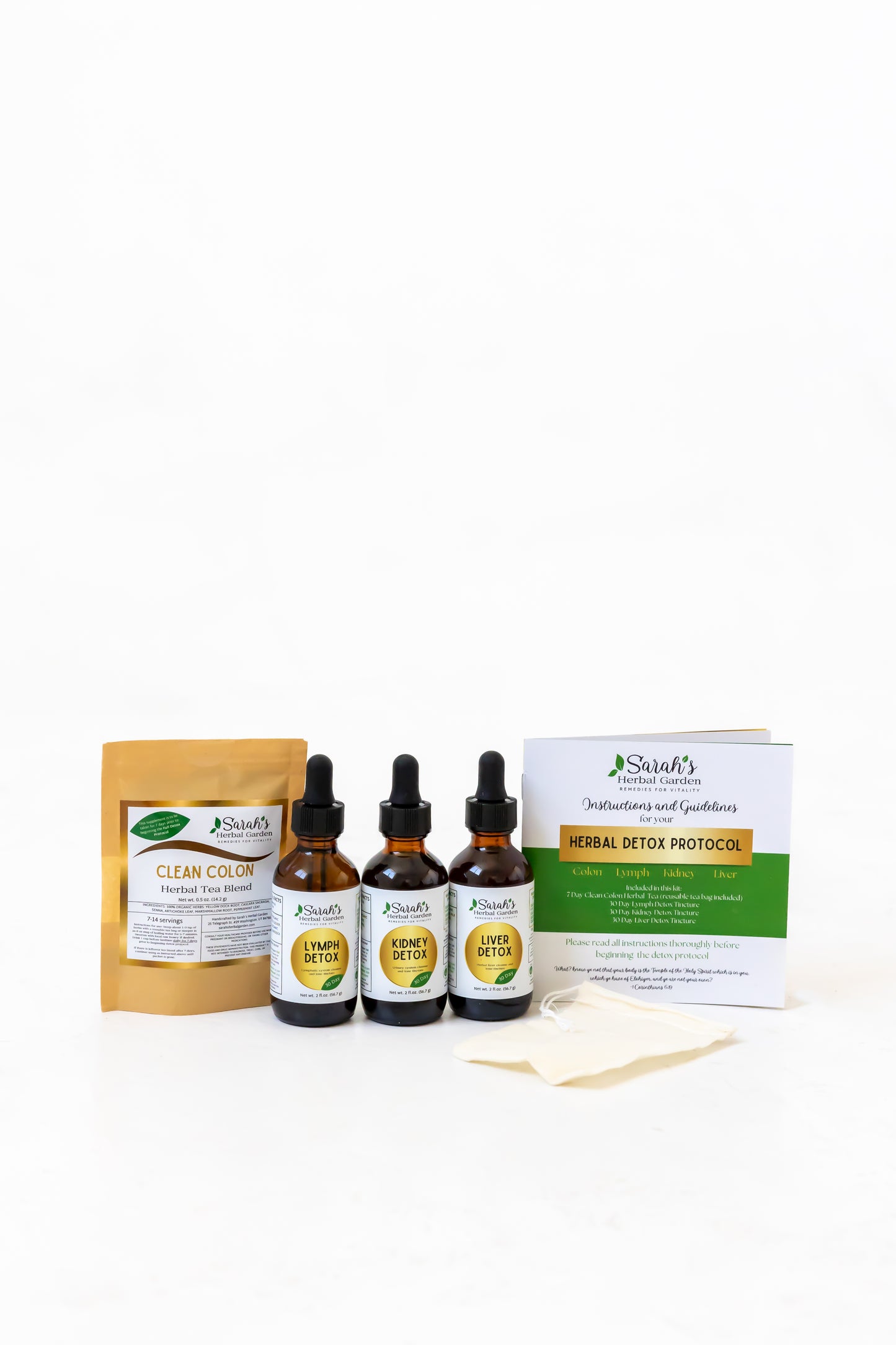


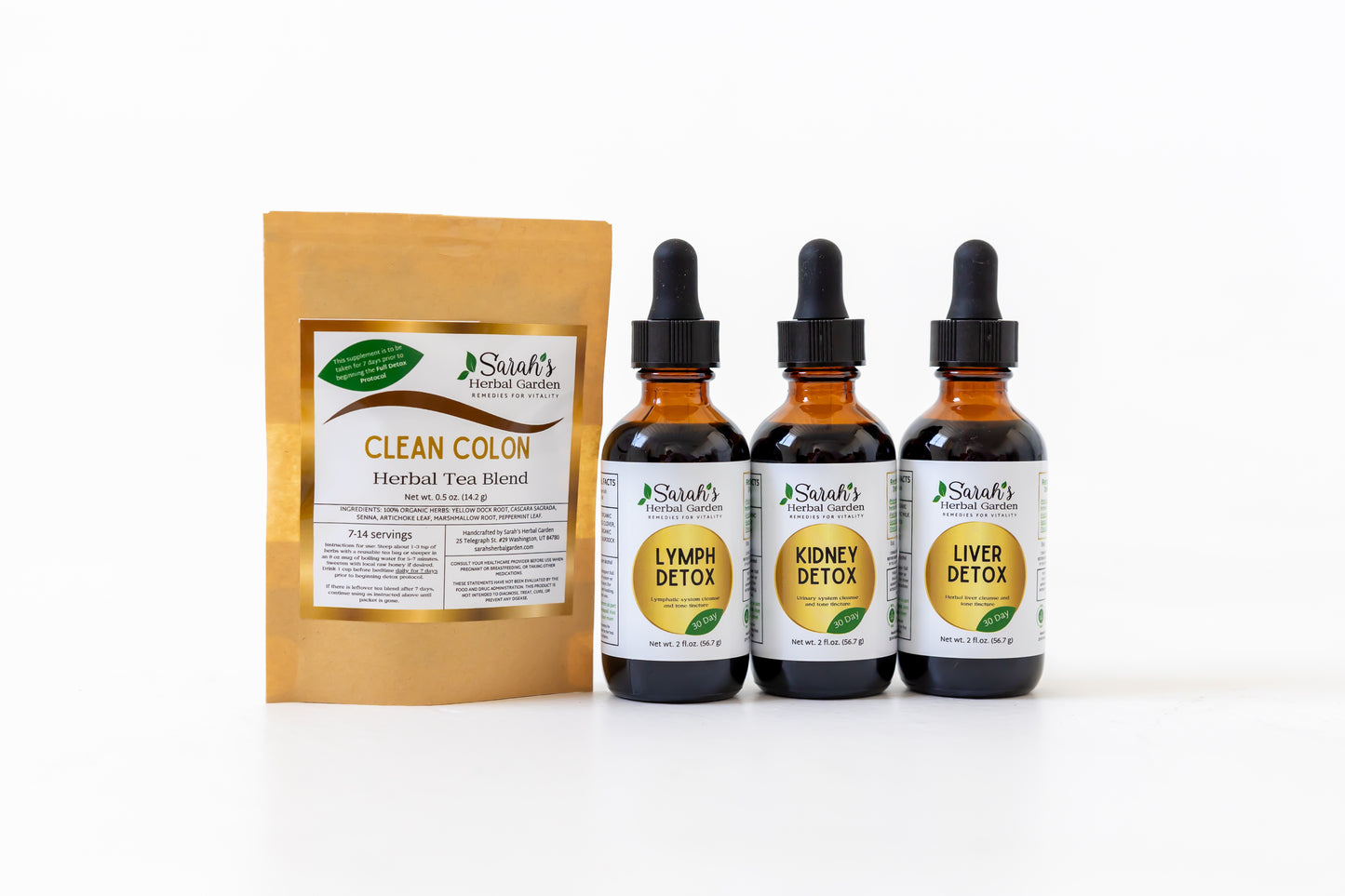

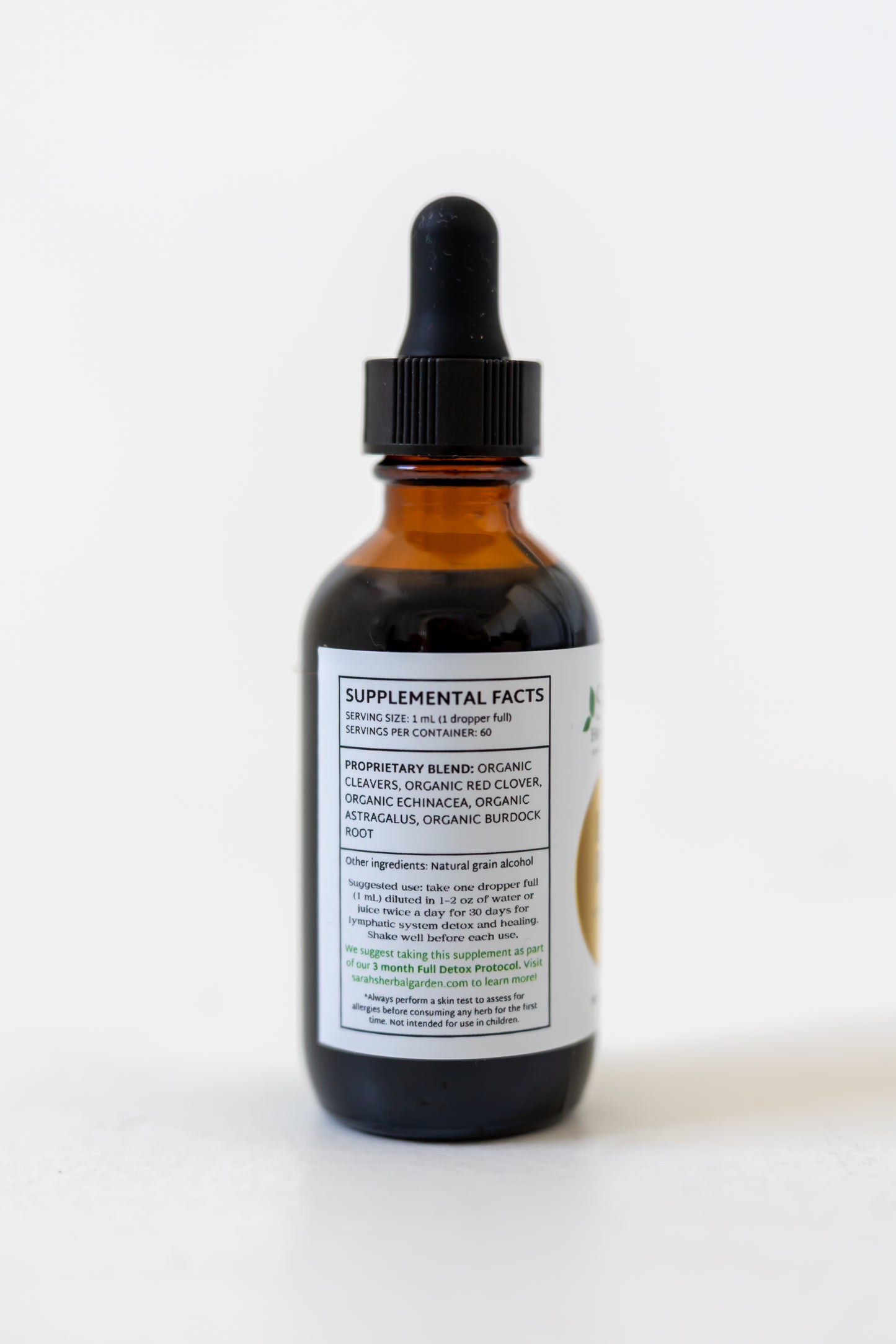


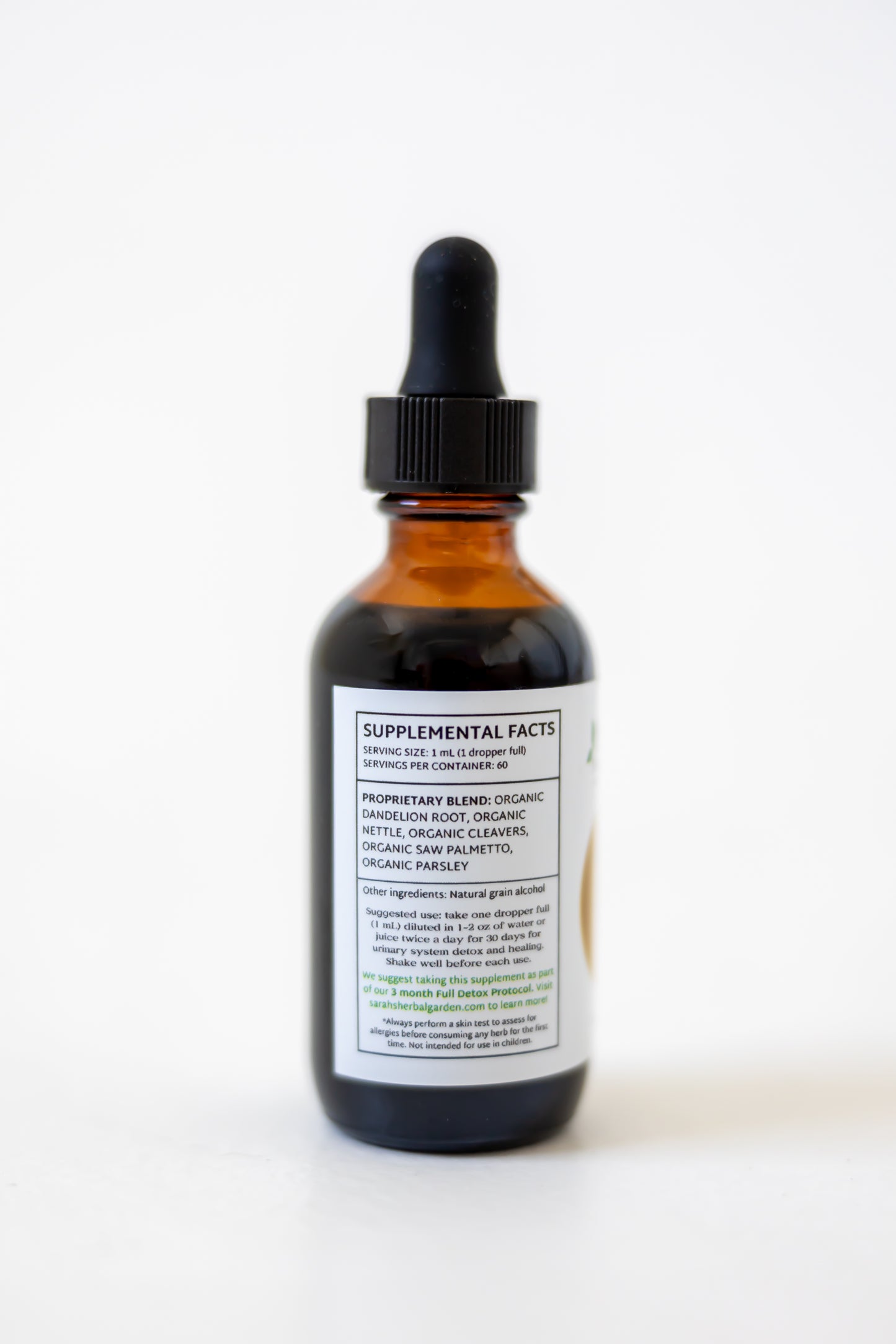



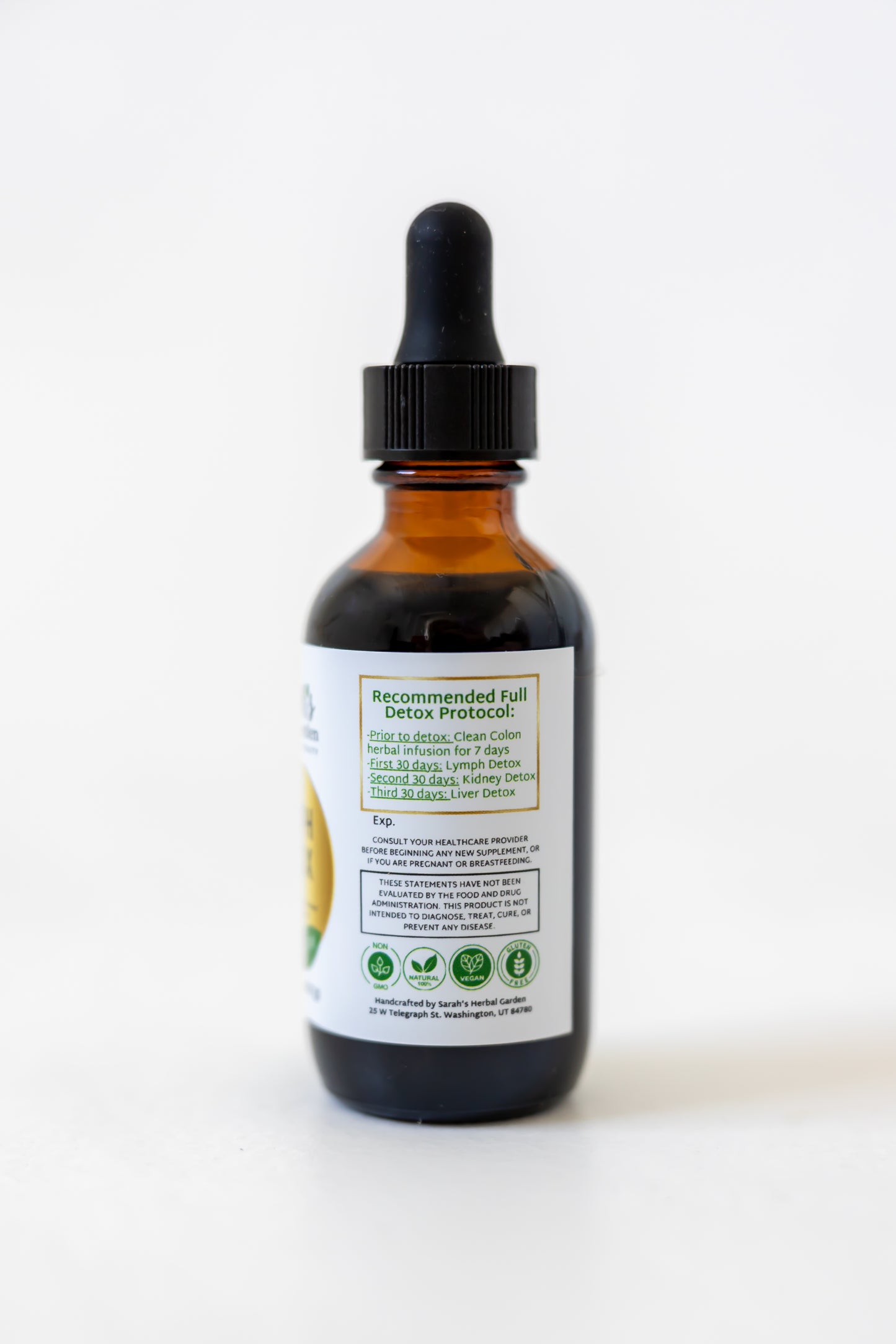
Step 2: Heavy Metal Detox
30 Day Protocol to remove harmful heavy metals such as lead, mercury, aluminum, cadmium, chromium, nickel, and thalium.
Sarah's Herbal Garden
Heavy Metal Detox Bundle
Share










Step 3: Parasite and Yeast Cleanse
30 day cleanse for intestinal worms and other harmful microbes, such as candida. Restore balance in the gut.
Sarah's Herbal Garden
Parasite Cleanse Bundle
Share
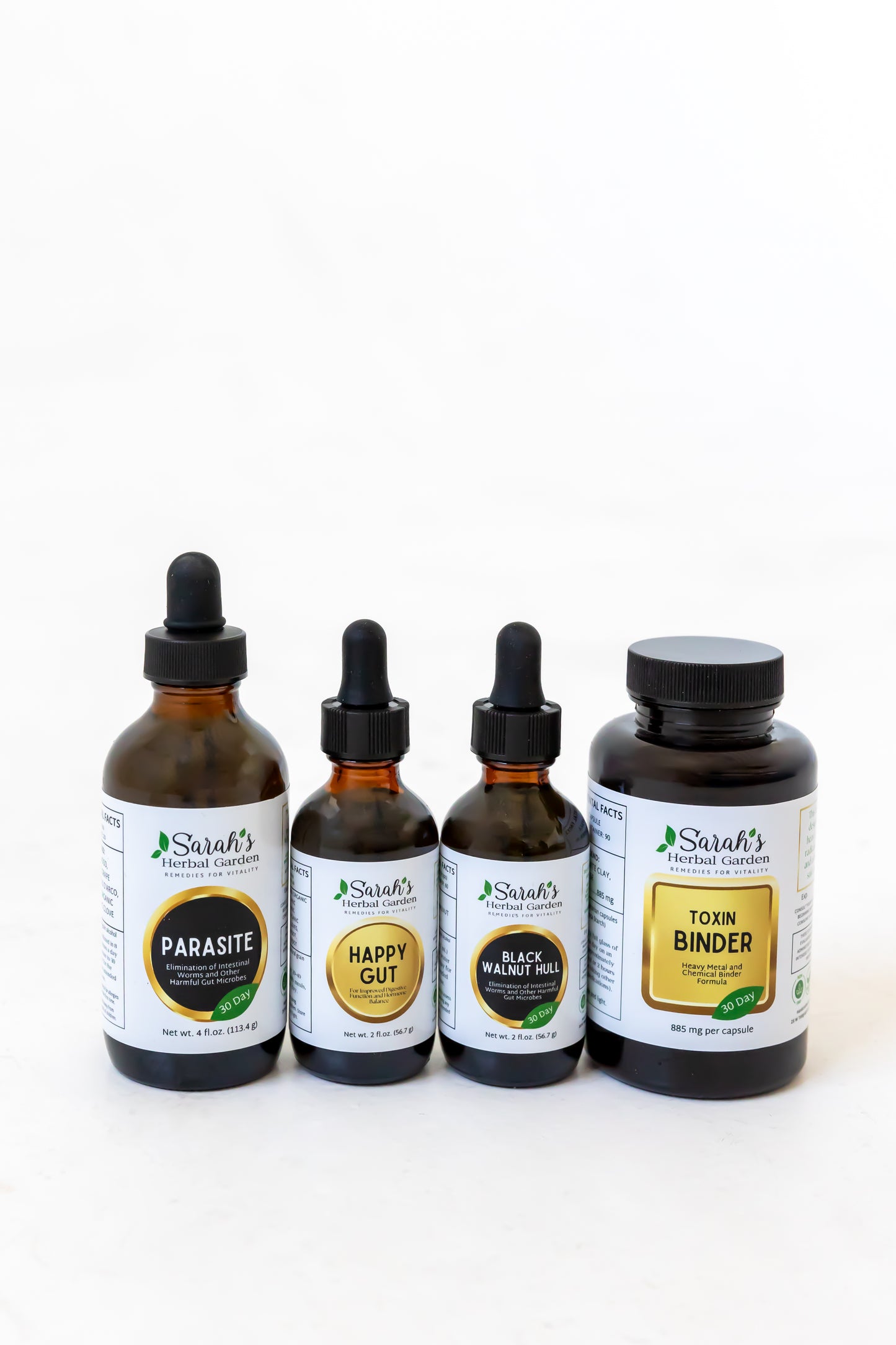









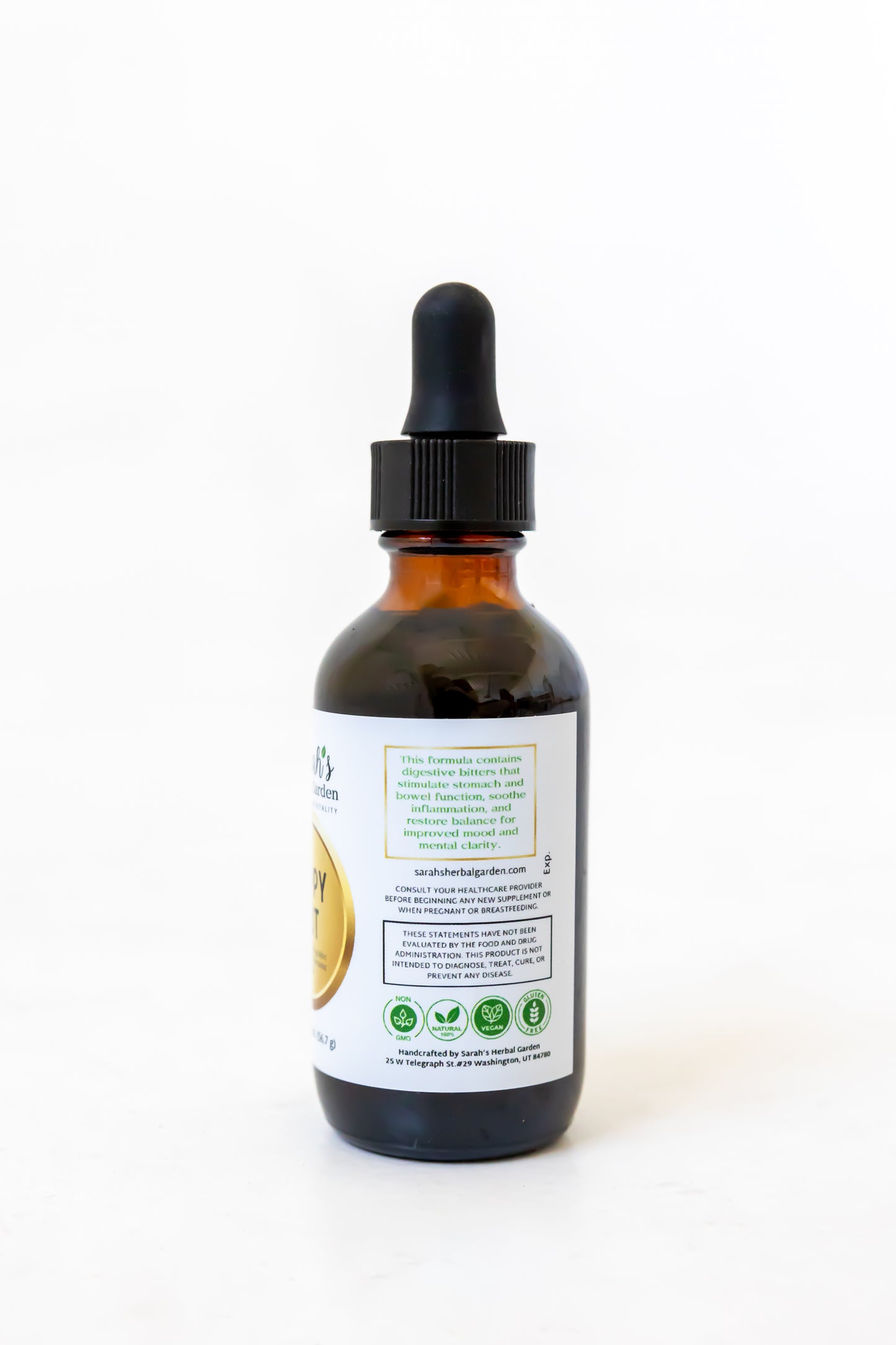


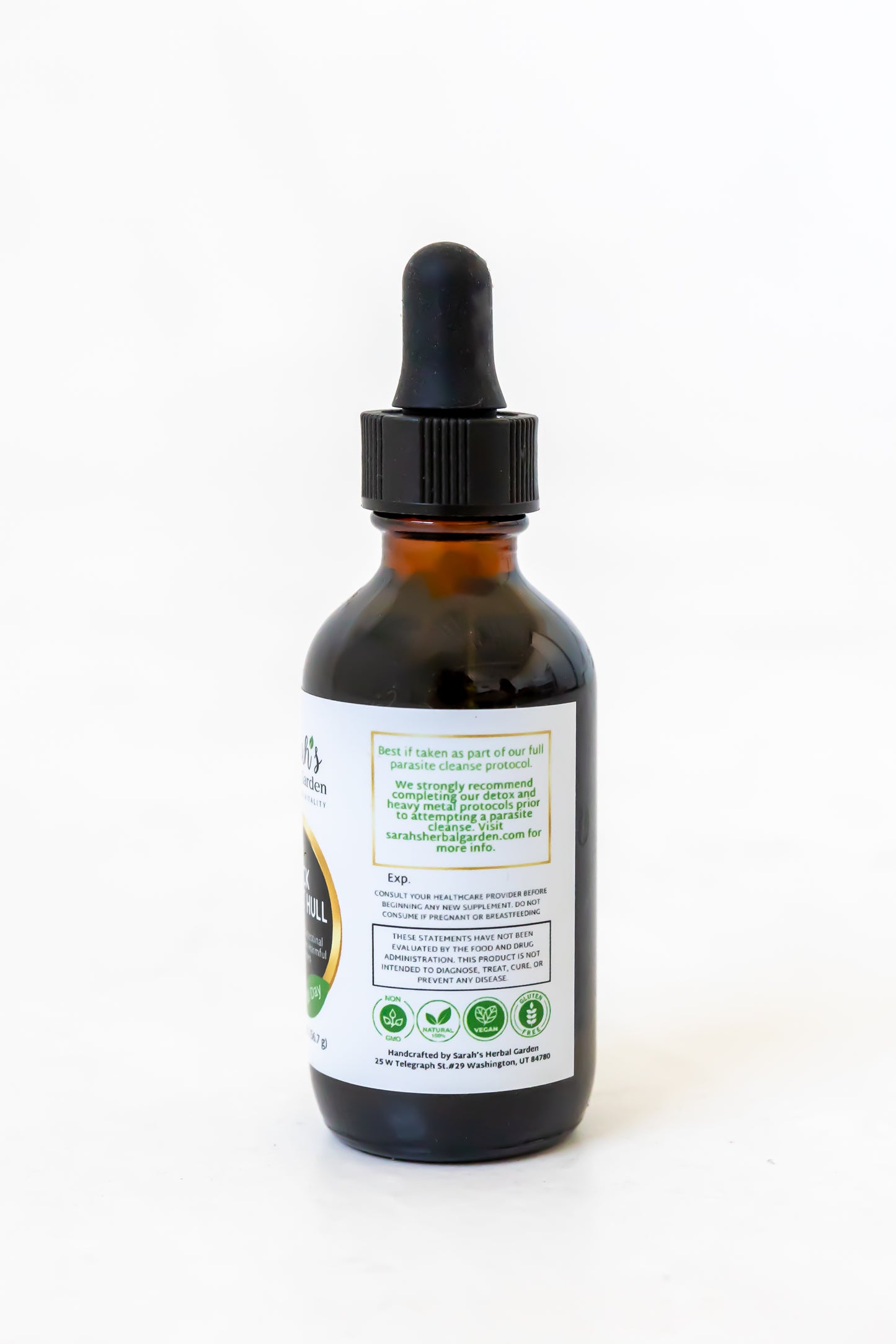
Sarah's Herbal Garden
Parasite Cleanse Bundle {No Black Walnut}
Share







































